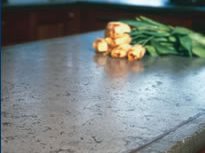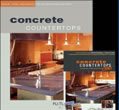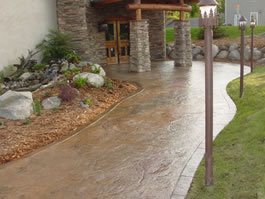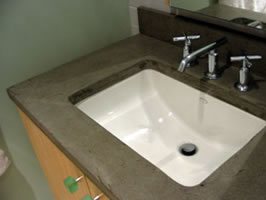- Staining Concrete
- Stamped Concrete
- Concrete Overlays
- Concrete Resurfacing
- Concrete Polishing
- Concrete Dyes
- Colored Concrete
- Indoor Concrete
- Concrete Floors
- Concrete Countertops
- Garage Floor Coatings
- Furniture, Sinks, Fire Bowls
- Basement Floors
- Outdoor Concrete
- Concrete Patios
- Concrete Driveways
- Concrete Pool Decks
- Outdoor Kitchens & Counters
- Outdoor Fireplace
- Concrete Walkways
- Concrete Pavers
- Concrete Walls
- Repair & Maintenance
- Foundation Repair
- Concrete Crack Repair
- Concrete Sealers
- Building with Concrete
- Concrete Homes
- Concrete Basements
- Decorative Concrete
- Fire Resistant
The Wabi-Sabi Movement and Concrete:
A Good Fit
Wabi-sabi: The Japanese art of finding beauty in natural imperfection. Photo courtesy of Buddy Rhodes Studio.
In our disposable society, the mantra could very well be, Out with the old, and in with the new. Luckily, wabi-sabi is quickly catching on, dispelling that disposable notion. Just as Sheryl Crows song Soak up the Sun advises, Its not having what you want, but wanting what youve got, wabi-sabi adheres to the same principles.
Wabi-sabi is about finding beauty in life in the moment. It acknowledges that nothing lasts, nothing is finished and nothing is perfectand thats O.K. In other words, rather than replace something thats slightly worn, try embracing its age and incorporating it into an aspect of your environment.Wabi-sabi is also about how you view and live within your surroundingsits an aesthetic that has very close ties to Zen Buddhism. Wabi-sabi, or the Japanese art of finding beauty in natural imperfection, has been evolving since its inception in Japanese culture in the seventeenth century.
Definition of Wabi-SabiLoosely translated, wabi means inner serenity, or an appreciation of less is more; sabi means outer beauty, or that which is worn and weathered due to the natural cycle of creation, decay and rebirth.Loosely interpreted, wabi means inner serenity, or an appreciation of less is more; sabi means outer
beauty, or that which is worn and weathered due to the natural cycle of creation, decay and rebirth.Today, wabi-sabi is touching everything from storefronts to kitchen countertops. In the kitchen, for example, wabi-sabi suggests a relaxed, comfortable, less cookie-cutter-looking space. Its about flowing countertops that incorporate nature, and floors that look like a forest floor you might find while hiking.
When applied to concrete, wabi-sabi means embracing the look and feel of natural surroundings. Its an aesthetic look of aged, worn, naturally colored materials.Wabi-sabi is also about using recycled materials, not just because theyre better for the environment, but also because these materials are weathered and have many cracks and flaws.Wabi-sabi uses organic (not synthetic) materials that are left unfinishedthey are not usually polished or cleaned or made to appear new. The objects are shaped naturally or organically, showing natural or intentional asymmetry or irregularity. In keeping with the material used, the texture remains rough, uneven, variegated and random.
Wabi-sabi uses materials that are not usually polished or cleaned or made to appear new. The objects are shaped naturally or organically, showing natural or intentional asymmetry or irregularity.In wabi-sabi, objects possess a different sense of beauty because they are in their most natural state. Colors are muted and typically derived from nature.
Wabi-sabi objects are simple in their form, and its the lack of manipulation of the work that makes them wabi-sabi. In wabi-sabi, nothing is wasted. The work reflects the physical balances found in the natural world. Theres no symmetry that is not found in nature.If words like natural, variegated and random sound familiar, its because those same words are often used to describe decorative concrete work. Wabi-sabi is about concrete floors, countertops and other elements that look natural.
Wabi-sabi is about concrete floors, countertops and other elements that look natural.Of course, wabi-sabi philosophy and aesthetic outlook can apply to the use of concrete, says Fu-Tung Cheng of Cheng Design. That said, we must not include the word decorative in reference to concrete and wabi-sabi.According to Cheng, wabi-sabi is anything but decoration. In fact, he says to over-define it or to formulize it into a few cute techniques is to miss the whole point of wabi-sabi.It is the un-intended, the aged, worn, simple or accidental that is considered to even qualify [as wabi-sabi]. Decoration implies an applied and contrived style, fashion or trend. These are antithetical to wabi-sabi, Cheng explains.
The earthiness and natural crazing that occurs in our Geocrete [countertop] surface, the occasional blemish, the imperfect finishthese are the un-intended interventions of the process of countertop making that, in the right context, can be considered a blush of wabi-sabi. If reduced to some simplistic formula, the very idea would become trite.
In Chengs book, Concrete Countertops: Design, Forms, and Finishes for the New Kitchen and Bath, he introduced the idea of a link in his own work to the principles of wabi-sabi because, he says, I felt that the idea of restraint, simplicity, and reference to nature was important in my work and sought to introduce the idea to the readers who might feel a kinship and emotional bond with those principles.

Purchase Concrete Countertops Book/DVD
Click Here
In fact, in my book, I was so reluctant to credit any of my work with that elusive quality, that I showed someone elses design of a kitchen as an example of a whole project that included concrete counters and deserved the recognition, Cheng continues.
Wabi-sabi is not about using: whether to beautify, decorate, exploit or incorporateits about how to appreciate its rare occurrence when it happens and be grateful for the consciousness to be aware of it, Cheng concludes. Its a feeling, and one of deep, connective recognition, that upon reflection, one sees out of the corner of ones eye. Like all things, great and small, that have great meaningit is elusive.
Every day, embrace the uneven, imperfect and aged, because thats what wabi-sabi is all about.







